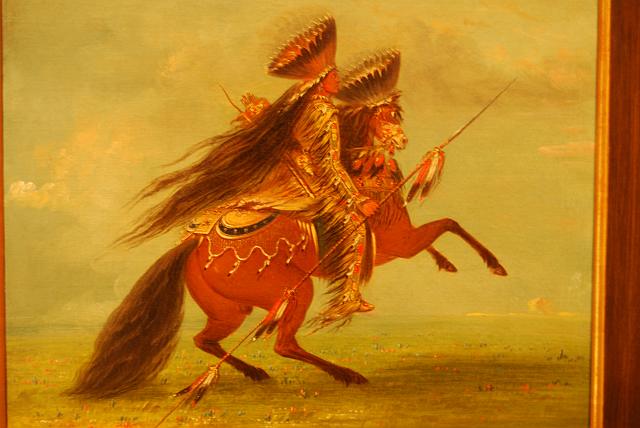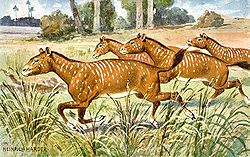| Home Index/Indians | First Posted: October 22, 2009 Jan 21, 2020 | |
Native Americans (Indians) and the Horse   Drawing by Red Horse, Curly Horse in Battle of Little Big Horn
Horses we know today were not native to North and South America. The Mesohippus, a three-toed horse that lived about 25,000,000 years ago became extinct on these continents. It was believed that the plain horses came from early explorers such as Cortez, that they were feral Spanish mustangs. This has proved to be a false notion. The North American Plains Indians acquired their first horses, and the knowledge of how to handle them, through trade with the Indians of the Southwest. American Indians had to learn to ride and handle horses just like everybody else. Some say that the horses arrived with the Spanish explorers like Coronada and DeSoto around 1540. It was said that some horses escaped or were left behind and their populations began to grow. However, according to an exhibit, "A Song for the Horse Nation" at the Smithsonian's National Museum of the American Indian in New York, the George Gustav Heye Center, the Spanish, and later, the French, English and Dutch, beginning with Columbus' second voyage in 1493, brought the horse. Native people soon adopted the horse and became some of the world's best horsemen. Horses were used to enhance trade, expand territory, facilitate hunting and wage war. It was not until much later that the Native Americans began to harness the magic of our equine friends. Horses became integrated in Native American cultural and spiritual life, representing the primary virtues of agility, grace and beauty. That knowledge and the taming of the horse changed Indian life forever. Of Interest: "Mesohippus was a three-toed horse that lived approximately twenty-five million years ago. The precursors of the horse family came into existence about fifty-five million years ago. The first was Eohippus. These prehistoric horses weighed about eighty pounds, had four toes on its front feet, three toes on its rear feet, and small teeth suitable for a diet of fruit and leaves. As these prehistoric horses increased in numbers and diversity, they spread across North America and, via the Bering Strait land bridge, to Europe and Asia. About fifteen thousand years ago, the North American habitat started to change and the prehistoric horses began to disappear. Horses were also a food source for Paleo-Indians, which contributed to horses becoming extinct on this continent." Plains Indian Horse Culture  Mesohippus (A three-toed horse that lived about 25,000,000)
Evolution of the Horse Video
As settlers and missionaries began to arrive in the 1600s, they settled in New Mexico and surrounding areas. The prevailing tribes were Pueblo and Navajo. Native Americans were forced to work on ranches. It was at this point that the Indians began to learn about the value of the horse--how to train, ride and use horses for packing. The Pueblo Indians unshackled themselves from the Spaniards in 1680 and drove the Spaniards from their Indian lands. In retreat, the Spaniards left many horses behind. The Pueblo Indians began to raise large herds. From there the Pueblo began to sell the horses to other tribes such as the Kiowa and Comanche. The Pueblo also taught these tribes about the ways of the horse. The horse trade spread rapidly across the southern plains. The Cheyenne tribe began to use horses around 1745. With the use of the horse hunting was made easier and more efficient, they had the ability to travel farther and faster than on foot and these tribes that had the use of the horse had an advantage over the other horseless tribes when it came to raiding and waring. Plains tribes such as the Apache, Wichita and Tonkawa were driven from their territorial lands by the tribes that had harnassed the horse power. In fact, Comanche warriers were feared by both the white settles and the other tribes. It is interesting to note that Native Americans had figured out how to use "dog power." Dogs were used for packing. So it was not a difficult leap to harness the use of the horse. Native Americans already had the knowledge to train and work with the dogs. The horse redirected Native American life forever. For More Information: Spanish Colonial Horse and the Plains-Indian CultureCayuse Indian Pony Gaited The Spreading of Horses in America |